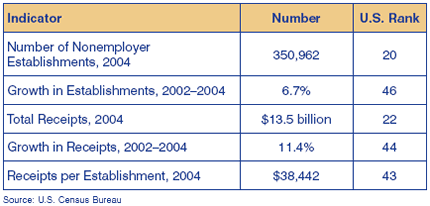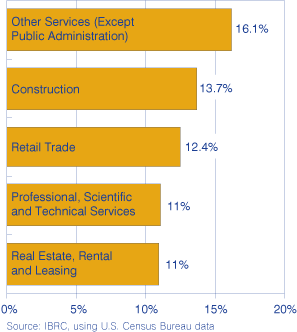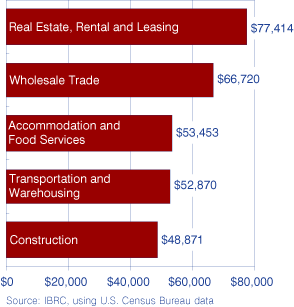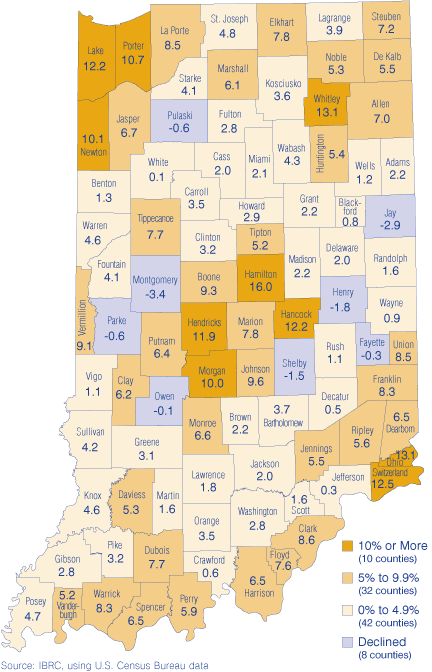I Did It My Way: Self-Employment on the Rise in Indiana
The lure of self-employment has always been strong. What is sacrificed in subsidized benefits, paid vacations and a steady paycheck is offset by the freedom to call your own shots and the sense of personal satisfaction (forgetting, for the moment, the endless hours, stress and anxiety). Despite the inherent risks, an increasing number of Hoosiers are accepting the challenge and going into business for themselves. According to the U.S. Census Bureau's Nonemployer Statistics, the number of Indiana businesses with no employees (dubbed nonemployer establishments) rose nearly 7 percent between 2002 and 2004 to 350,962 establishments. Indiana's $13.5 billion in total receipts (1) for 2004 represents an 11 percent increase over 2002. These growth rates, though positive, are among the nation's lowest over this period (see Table 1).
Table 1: Indiana Nonemployer Establishments at a Glance

A nonemployer establishment is defined as a business that has no paid employees, has annual business receipts of $1,000 or more and is subject to federal income taxes. The vast majority of nonemployer establishments are sole proprietorships, although partnerships and corporations that have no employees are counted as well. These establishments may or may not be the owner's primary source of income. Many are certainly small, representing little more than hobbyists in some cases, and generate modest income. Others are very profitable and will expand and create jobs in the future. Of course, these figures do not represent all self-employed individuals because some do employ others.
As Figure 1 illustrates, the largest percentage of Indiana's nonemployer establishments falls under the category of other services (16.1 percent), which includes industries ranging from automotive repair to hair and nail salons. Other sectors with large numbers of self-employed individuals include construction (13.7 percent); retail trade (12.4 percent); professional, scientific and technical services (11.0 percent); and real estate, rental and leasing (10.9 percent). These also represent the top five sectors nationally, although in a somewhat different order.
Figure 1: Indiana's Top Five Nonemployer Industries as a Percent of the Total, 2004

How do these one person enterprises translate into economic activity? The other services sector, for example, holds the largest share of nonemployer establishments, but in 2004 it generated some of the lowest annual receipts per establishment ($20,631) among Indiana's industries. The real estate, rental and leasing sector led the state with $77,414 in annual receipts per establishment in 2004, followed by wholesale trade at $66,720 (see Figure 2).
Figure 2: Indiana's Top Five Nonemployer Industries by Receipts per Establishment, 2004

Growth in Nonemployer Establishments
As one would expect, some of Indiana's most dramatic recent growth rates can be attributed to the Internet. Sub-industries such as Internet service providers and Web search portals (84 percent), Internet publishing and broadcasting (80 percent), and electronic shopping and mail-order houses (44 percent) saw impressive growth between 2002 and 2004. Despite these gains, the state's information industry accounted for only 1 percent of the total nonemployer establishments in 2004. The real estate, rental and leasing industry's 12.7 percent growth was the highest among Indiana's larger sectors.
In terms of geography, recent growth in nonemployer establishments appears to be influenced greatly by proximity to metropolitan areas. Indiana counties that are part of a larger MSA account for 11 of the top 12 counties in terms of growth (see Figure 3). Hamilton County leads the state with a 16.0 percent growth rate followed by Whitley (13.1 percent), Ohio (13.1 percent), Switzerland (12.5 percent), and Hancock (12.2 percent) counties. Eight counties saw the number of nonemployers decline between 2002 and 2004.
Figure 3: Percent Change in Nonemployer Establishments, 2002 to 2004

County Comparison
So which Indiana counties have the greatest number of nonemployer establishments per capita? Figure 4 illustrates the ratio of adults (population 18 and above) to nonemployer establishments in 2004 for each county. Lagrange County leads the state with a ratio of 8.1 adults to each nonemployer establishment. Adams, Hamilton, Brown and Boone counties also have fewer than 10 adults to each establishment. Keep in mind that this measurement can be skewed somewhat as some individuals operate multiple establishments.
Figure 4: Per Capita Measure of Nonemployer Establishments, 2004

Note
Receipts include gross receipts, sales, commissions and income from trades and businesses, as reported on annual business income tax returns. Business income consists of all payments for services rendered by nonemployer businesses, such as payments received as independent agents and contractors.
The composition of nonemployer receipts may differ from that of the related data item that is published for employer establishments. For example, for wholesale agents and brokers without payroll, the receipts item contains commissions received or earnings. In contrast, for wholesale agents and brokers with payroll, the sales item published in the economic census represents the value of the goods involved in the transactions.
Matt Kinghorn, Economic Research Analyst
Indiana Business Research Center, Kelley School of Business, Indiana University
